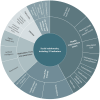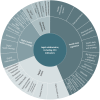Assessing the Digital Advancement of Public Health Systems Using Indicators Published in Gray Literature: Narrative Review
- PMID: 39566910
- PMCID: PMC11618018
- DOI: 10.2196/63031
Assessing the Digital Advancement of Public Health Systems Using Indicators Published in Gray Literature: Narrative Review
Abstract
Background: Revealing the full potential of digital public health (DiPH) systems requires a wide-ranging tool to assess their maturity and readiness for emerging technologies. Although a variety of indices exist to assess digital health systems, questions arise about the inclusion of indicators of information and communications technology maturity and readiness, digital (health) literacy, and interest in DiPH tools by the society and workforce, as well as the maturity of the legal framework and the readiness of digitalized health systems. Existing tools frequently target one of these domains while overlooking the others. In addition, no review has yet holistically investigated the available national DiPH system maturity and readiness indicators using a multidisciplinary lens.
Objective: We used a narrative review to map the landscape of DiPH system maturity and readiness indicators published in the gray literature.
Methods: As original indicators were not published in scientific databases, we applied predefined search strings to the DuckDuckGo and Google search engines for 11 countries from all continents that had reached level 4 of 5 in the latest Global Digital Health Monitor evaluation. In addition, we searched the literature published by 19 international organizations for maturity and readiness indicators concerning DiPH.
Results: Of the 1484 identified references, 137 were included, and they yielded 15,806 indicators. We deemed 286 indicators from 90 references relevant for DiPH system maturity and readiness assessments. The majority of these indicators (133/286, 46.5%) had legal relevance (targeting big data and artificial intelligence regulation, cybersecurity, national DiPH strategies, or health data governance), and the smallest number of indicators (37/286, 12.9%) were related to social domains (focusing on internet use and access, digital literacy and digital health literacy, or the use of DiPH tools, smartphones, and computers). Another 14.3% (41/286) of indicators analyzed the information and communications technology infrastructure (such as workforce, electricity, internet, and smartphone availability or interoperability standards). The remaining 26.2% (75/286) of indicators described the degree to which DiPH was applied (including health data architecture, storage, and access; the implementation of DiPH interventions; or the existence of interventions promoting health literacy and digital inclusion).
Conclusions: Our work is the first to conduct a multidisciplinary analysis of the gray literature on DiPH maturity and readiness assessments. Although new methods for systematically researching gray literature are needed, our study holds the potential to develop more comprehensive tools for DiPH system assessments. We contributed toward a more holistic understanding of DiPH. Further examination is required to analyze the suitability and applicability of all identified indicators in diverse health care settings. By developing a standardized method to assess DiPH system maturity and readiness, we aim to foster informed decision-making among health care planners and practitioners to improve resource distribution and continue to drive innovation in health care delivery.
Keywords: digital health; digital public health; gray literature; health system; indicator; information and communications technology; interdisciplinary; maturity assessment; mobile phone; narrative review; readiness assessment.
©Laura Maaß, Manuel Badino, Ihoghosa Iyamu, Felix Holl. Originally published in JMIR Public Health and Surveillance (https://publichealth.jmir.org), 20.11.2024.
Conflict of interest statement
Conflicts of Interest: None declared.
Figures





Similar articles
-
International perspectives on measuring national digital public health system maturity through a multidisciplinary Delphi study.NPJ Digit Med. 2024 Apr 12;7(1):92. doi: 10.1038/s41746-024-01078-9. NPJ Digit Med. 2024. PMID: 38609458 Free PMC article.
-
Digital Health Policy and Programs for Hospital Care in Vietnam: Scoping Review.J Med Internet Res. 2022 Feb 9;24(2):e32392. doi: 10.2196/32392. J Med Internet Res. 2022. PMID: 35138264 Free PMC article.
-
The future of Cochrane Neonatal.Early Hum Dev. 2020 Nov;150:105191. doi: 10.1016/j.earlhumdev.2020.105191. Epub 2020 Sep 12. Early Hum Dev. 2020. PMID: 33036834
-
Beyond the black stump: rapid reviews of health research issues affecting regional, rural and remote Australia.Med J Aust. 2020 Dec;213 Suppl 11:S3-S32.e1. doi: 10.5694/mja2.50881. Med J Aust. 2020. PMID: 33314144
-
Health economic evaluation of preventive digital public health interventions using decision-analytic modelling: a systematized review.BMC Health Serv Res. 2023 Mar 17;23(1):268. doi: 10.1186/s12913-023-09280-3. BMC Health Serv Res. 2023. PMID: 36932436 Free PMC article. Review.
Cited by
-
From Theory to Practice: Viewpoint on Economic Indicators for Trust in Digital Health.J Med Internet Res. 2025 Jan 15;27:e59111. doi: 10.2196/59111. J Med Internet Res. 2025. PMID: 39813672 Free PMC article.
-
Considerations for adapting digital competencies and training approaches to the public health workforce: an interpretive description of practitioners' perspectives in Canada.BMC Public Health. 2025 Jan 10;25(1):122. doi: 10.1186/s12889-024-21089-1. BMC Public Health. 2025. PMID: 39794767 Free PMC article.
References
-
- Assessing the impact of digital transformation of health services: report of the expert panel on effective ways of investing in health (EXPH) European Commission. 2019. [2024-04-29]. https://health.ec.europa.eu/system/files/2019-11/022_digitaltransformati... .
-
- Saisó SG, Marti MC, Medina FM, Pascha VM, Nelson J, Tejerina L, Bagolle A, D'Agostino M. Digital transformation for more equitable and sustainable public health in the age of digital interdependence. Am J Public Health. 2022 Aug;112(S6):S621–4. doi: 10.2105/AJPH.2022.306749. https://doi.org/10.2105/AJPH.2022.306749 - DOI - DOI - PMC - PubMed
-
- Iyamu I, Xu AX, Gómez-Ramírez O, Ablona A, Chang HJ, Mckee G, Gilbert M. Defining digital public health and the role of digitization, digitalization, and digital transformation: scoping review. JMIR Public Health Surveill. 2021 Nov 26;7(11):e30399. doi: 10.2196/30399. https://publichealth.jmir.org/2021/11/e30399/ v7i11e30399 - DOI - PMC - PubMed
-
- Odone A, Buttigieg S, Ricciardi W, Azzopardi-Muscat N, Staines A. Public health digitalization in Europe. Eur J Public Health. 2019 Oct 01;29(Supplement_3):28–35. doi: 10.1093/eurpub/ckz161. http://europepmc.org/abstract/MED/31738441 5628048 - DOI - PMC - PubMed
-
- Gunasekeran DV, Tham YC, Ting DS, Tan GS, Wong TY. Digital health during COVID-19: lessons from operationalising new models of care in ophthalmology. Lancet Digit Health. 2021 Feb;3(2):e124–34. doi: 10.1016/S2589-7500(20)30287-9. https://linkinghub.elsevier.com/retrieve/pii/S2589-7500(20)30287-9 S2589-7500(20)30287-9 - DOI - PubMed
Publication types
MeSH terms
LinkOut - more resources
Full Text Sources
Research Materials

